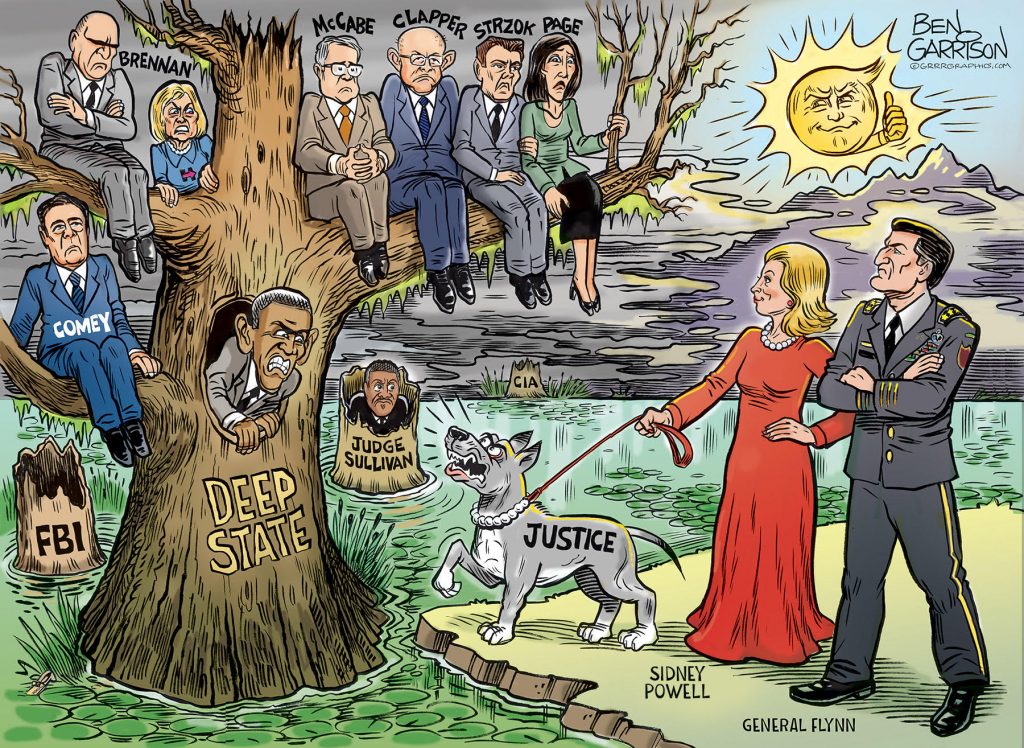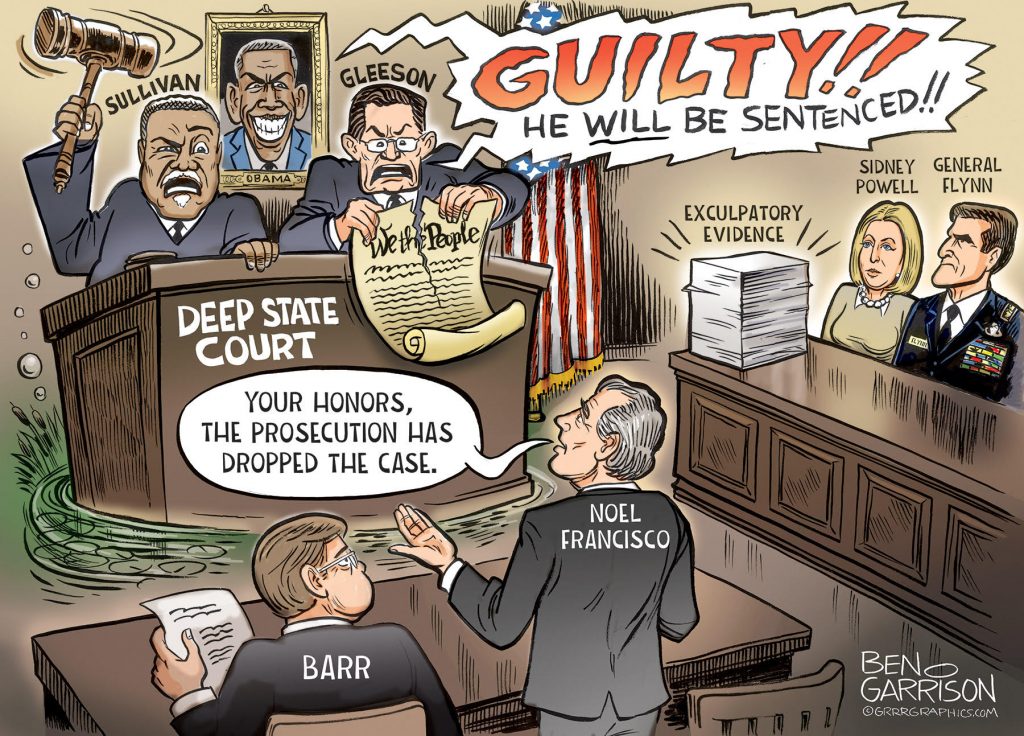Cartoon Source with Accompanying Text — may be reprinted with source link.
Reading the appellate en banc opinion as Judge Sullivan readies a hearing in the Michael Flynn case
Note portions highlighted in red. Turley analysis linked at end.
By Robert Willmann
The 10 judges on the District of Columbia Court of Appeals eligible to rehear a three-judge panel's decision in favor of Michael Flynn's petition for a writ of mandamus cancelled the panel's prior ruling with an 8-2 vote. Flynn's attorneys have decided they will not ask the U.S. Supreme Court whether it will agree to hear that mandamus action. In the trial court, Judge Emmet Sullivan has set a hearing for oral argument on the request by the Department of Justice to dismiss the criminal case against Flynn. The hearing is scheduled for Tuesday, 29 September 2020, at 11:00 a.m. eastern time.
All of the judges eligible on the D.C. Circuit Court of Appeals to participate in a rehearing of the mandamus action did so as a group called “en banc”. Eight judges decided to deny all the relief requested by Flynn, with seven of them agreeing on a majority opinion, plus one who filed a concurring opinion. Two judges wrote dissenting opinions. The primary author of the majority opinion was not revealed, as the generic term “per curiam” was used. The decision and opinions were handed down on 31 August 2020, and were made available here on SST that day [1].
Reading past the language on the surface of the en banc majority opinion makes it clear as to what was going on. The opinion is carefully designed to minimize the chances that the supreme court would decide to hear the mandamus case at this stage of the proceedings. Neither the law applicable to a federal government's motion to dismiss under Rule of Criminal Procedure 48(a), nor the facts of Flynn's case in the trial court, were discussed at all. Not one time. Nothing. Only a passing reference was made to harms to Flynn and the Department of Justice (DOJ) if a mandamus order was not issued, but those harms were waved away as either being speculative or no big deal. A real issue exists about whether Judge Sullivan was disqualified or should be recused from presiding over the case. However, the supreme court would probably not think that the issue by itself would justify getting involved in the case. The 8-judge majority smiled and said that the mandamus action was premature, since Sullivan had not yet ruled on the motion to dismiss. That is a position that has a certain logic to it, if what has occurred in the trial court is ignored. They also minimized and blew by the evidence of Sullivan's partiality and bias, and refused to remove him as the judge presiding. And they allowed John Gleeson to continue as an outside lawyer and “friend of the court”, to argue against dismissing the case.
You can now see why Sidney Powell, and the other two lawyers representing Flynn, decided not to approach the supreme court at this time. The en banc majority opinion was sanitized to the extent that an analysis of the government's motion to dismiss, and the circumstances in which a judge might grant or deny it, was nowhere to be found.
The 7-judge court of appeals opinion both liked and disliked speculation. When Sullivan's lawyer said at oral argument that he might end up granting the motion to dismiss, which is speculation, that became a reason to support the decision to deny mandamus (opinion, page 7). When the DOJ argued that there would be harms to the constitutional separation of powers if mandamus was not granted, that was not a reason for a mandamus, and was “speculative” (page 10). When Flynn and the DOJ argued that trial court activity might result in intrusive questions into executive branch decision-making, discovery procedures, and additional charges of a criminal nature, that was “speculative and may never come to pass” (page 11). Your tax dollars at work.
D.C. Circuit Judge Thomas Griffith wrote a short concurring opinion to try to give himself, and the other seven, some cover. He went along with the rationale that Sullivan had not yet ruled on the motion to dismiss, but was the only one of the majority of eight who even mentioned — in a diplomatic way — that under existing law the case is to be dismissed–
“Moreover, as its counsel repeatedly stated at oral argument, the district court may well grant the Government’s motion to dismiss the case against General Flynn. In fact, it would be highly unusual if it did not, given the Executive’s constitutional prerogative to direct and control prosecutions and the district court’s limited discretion under Rule 48(a), especially when the defendant supports the Government’s motion. But if the court denies the motion, General Flynn has multiple avenues of relief that he can pursue. And because he does, mandamus is not appropriate in this case at this time”.
The 7-judge majority opinion did some signalling to Judge Sullivan. One example is on page 12–
“Nothing in this decision forecloses the possibility of future mandamus relief should the District Court’s disposition of the motion to dismiss or other order violate the separation of powers or some other clear and indisputable right. We need not and do not now pass on the issues that might be presented by such a mandamus petition ….”
That statement is not as reassuring as it sounds. One of the elements of the federal mandamus doctrine is that “the party seeking issuance of the writ has no other adequate means to attain the relief he desires”. The majority opinion kicked off its discussion on page 5 by quoting from a 1967 supreme court decision: “A petition for a writ of mandamus ‘may never be employed as a substitute for appeal' “. That broad principle is limited by the right to a mandamus order if you have no other “adequate” means to get the relief you desire.
One tough aspect of this is that Flynn cannot do a regular “direct appeal” until the case ends in the trial court with a final judgment. If Judge Sullivan denies all of Flynn's requests, pushes forward to sentencing, and puts him on probation or sends him to prison, he cannot start a direct appeal until all of that happens. Thus, if Sullivan denies the motion to dismiss fairly soon and Flynn immediately files a new mandamus action in the court of appeals, the D.C. Circuit could again refuse to issue a mandamus order by saying that he still has an “adequate means” to attack the denial of the motion to dismiss by a regular appeal after the case concludes in the trial court.
On 24 June 2020, the three-judge panel ruled 2-1 for Flynn and ordered Sullivan to grant the government's motion to dismiss. Even though the date the mandamus order would have officially become effective had not arrived, Sullivan could have granted the dismissal immediately, because when a mandamus action is filed in a court of appeals, activity is not automatically suspended in the trial court. An appellate court would have to make a separate order “staying” some or all activity in the trial court first, which did not happen here. But Sullivan did nothing. He waited until the last minute before the mandamus order became effective, and illegally filed his request for a rehearing en banc on 9 July 2020. He had no authority to file a motion for rehearing. The 7-judge majority opinion tap danced to get around this problem by saying on page 4, “An active member [singular] of the court also made a sua sponte suggestion that the case be reheard en banc”.
On 31 August 2020, the en banc court of appeals denied a mandamus, ruling in Judge Sullivan's favor. This time he did not wait, and the very next day became busy as a bee.
On 1 September 2020, Sullivan said that an order denying mandamus relief will become effective automatically 21 days after it was issued. He told the parties to file a joint status report by 21 September about setting a briefing schedule and a time for oral argument.
The parties replied early on 4 September and asked for an expedited schedule with no more briefing necessary. Sullivan agreed to it and ordered John Gleeson to file his reply brief as amicus curiae by 11 September, since it was not filed earlier because the mandamus action was pending.
On 6 September Sullivan wanted the DOJ, Flynn, and Gleeson to deliver to his office by 10 September three printed courtesy copies of some specific documents they had previously filed with the trial court clerk. This was unusual given the electronic filing system in the federal courts. The documents were to be: “… submitted in binders, three-hole punched, with single- sided pages. All exhibits shall be tabbed and indexed for ease of reference. The parties shall deliver to Chambers three courtesy copies of any future filing, including exhibits, in connection with [docket number] 198 the Government's motion to dismiss”. These paper copies would likely be for Sullivan and his law clerks.
On 10 September, Flynn's attorneys bundled up into one filing the petition for a writ of mandamus, the reply brief in that action, the opposition to a rehearing en banc, and transcripts of the oral arguments before the three-judge panel and the en banc judges. These were filed with the clerk of the trial court to further add to the record there.
Then the fun started.
The DOJ became irritated after the court of appeals scoffed at its argument about the separation of powers between the executive and judicial branches. Determined to maintain control over its own turf, which includes the discretion to file and dismiss federal criminal charges, the DOJ released more exculpatory and mitigating material last week that should have been turned over to Flynn by the FBI or Robert Mueller and the Special Counsel's Office. Flynn promptly filed it with the trial court clerk on 24 September as part of a supplement to the agreed motion to dismiss the case. There are redactions. The main document had five attached exhibits. Because scanned exhibits can take up a lot of disk space, only exhibit 5 is included here, which has text messages from July 2016 to May 2017. The main document also has some text messages inserted in it–
https://turcopolier.typepad.
https://turcopolier.typepad.
On 24 September, the DOJ filed a supplement to its motion to dismiss with the trial court clerk. Attached as an exhibit is a 13-page summary of an interview with FBI agent William Barnett (who came with a lawyer), in the standard “302” form. The interview was conducted on 17 September 2020, two and a half weeks after the en banc court of appeals denied the madamus. With a straight face and in bureaucratic language, the DOJ said–
“… we noted that beginning in January 2020, the United States Attorney for the Eastern District of Missouri has been conducting an ongoing review of the FBI investigation that led to charges in this case. … Pursuant to that continuing review, an interview was recently conducted of the former case agent, SA William Barnett, who handled the counterintelligence investigation of Mr. Flynn, and was thereafter assigned to the Special Counsel’s Office investigating Russian interference in the 2016 Presidential Election”.
Behind the bland language, the DOJ was striking back after the court of appeals rejected the mandamus. To boost the evidence in support of its motion to dismiss, the DOJ arranged for Barnett to be interviewed, even though it could have been done earlier and before the motion to dismiss was filed on 7 May 2020. Larry Johnson noticed the interview summary and discussed it [2]. Here are the DOJ supplement and the interview–
https://turcopolier.typepad.
https://turcopolier.typepad.
Judge Sullivan ordered on 23 September 2020 that John Gleeson can participate in the oral argument as a friend of the court (and against dismissing the prosecution). As was discussed here on SST, Gleeson was in the U.S. Attorney's Office for the Eastern District of New York when Andrew Weissmann was hired in 1991 to work there [3]. Weissmann became the main deputy to Robert Mueller during the special counsel's Russia investigation starting in May 2017. In my opinion, Gleeson will try to present what amounts to a defense for Weissmann and the Mueller group, because a dismissal of the Flynn prosecution will discredit the Mueller investigation and may create more options for legal civil action against members of Mueller's office; personnel at the FBI, CIA, and DOJ; and Flynn's former lawyers at the large law firm of Covington & Burling.
Judge Sullivan may not announce a decision at the end of the court hearing. He may instead say that he is taking it under advisement and a written ruling will be issued later. How much later? The court of appeals signalled in the 7-judge opinion that they “trust and expect the District Court to proceed with appropriate dispatch”. If Sullivan wants to delay, he may wait until sometime after the November election. If he grants the motion to dismiss at the hearing or soon thereafter, it would be surprising, and run counter to his previous behavior.
An interesting item is standing by the side of the road. It concerns whether Flynn can jump over the court of appeals and apply directly to the U.S. Supreme Court if the motion to dismiss is denied. Supreme Court Rule 20 allows it, but with tight limits–
“1. …To justify the granting of any such writ, the petition must show that the writ will be in aid of the Court’s appellate jurisdiction, that exceptional circumstances warrant the exercise of the Court’s discretionary powers, and that adequate relief cannot be obtained in any other form or from any other court”.
The hearing will be by teleconference. The public can listen to the hearing by dialing certain telephone numbers. How many people can listen through each number is not known. It will probably be like rolling the dice to get a phone connection. Sullivan's order about the hearing states–
“Minute Order as to Michael T. Flynn. The motion hearing scheduled for September 29, 2020 at 11:00 AM shall now take place via Video Teleconference (VTC). The Courtroom Deputy Clerk shall contact the parties to provide the dial-in information. The public and media may listen to the hearing by dialing in to one of the following teleconference numbers and entering the access code when prompted: 877-336-1839 (access code 5524636); 888-363-4734 (access code 6114909); 877-336-1839 (access code 1429888); 877-402-9753 (access code 2090166); 888-557-8511 (access code 4140864); 888-273-3658 (access code 1773796). Persons joining via teleconference will be automatically muted and will not be heard by the Court or participants in the hearing. Signed by Judge Emmet G. Sullivan on 9/25/2020. (lcegs3) (Entered: 09/25/2020)”.
Cartoon Source with Accompanying Text — may be reprinted with source link.
See Also:
Jonathan Turley, “Dismiss the case of Michael Flynn,” The Hill, 29 September 2020
Michael Flynn’s lawyer says she asked Trump not to pardon the former national security adviser
It is clear to me as an observer that Judge Sullivan and his elective attorney are in a conspiracy to destroy General Flynn. The recently released texts and emails make it quite clear that General Flynn was entrapped and framed.
The time has come for Judge Sullivan to depart the bench in shame.
UPDATE:






